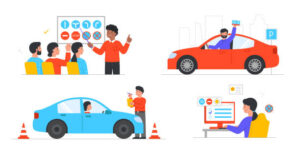Exam Preparation for Driving Theory, SERU & PCO
Transport laws and signs and hazards perceptions for Driving Theory test can be fun to learn! You can learn SERU English within a short time if you learn systematically. Only practicing on apps doesn’t cover all types of question. You need to follow the TFL guide Topographic mapping. The topographic part of PCO is easy when you know all signs and symbols on the the maps! Try with us! We’ll make your life easier!
Oxons College has set out to establish itself as one of the leading organisations in the country administering English programmes for different ages, walks, occupations and professions. Stage of education process in driving school. Set of characters receive driver license, take online test, pass exam with instructor at circuit and study rules of road.
Stage of education process in driving school. Set of characters receive driver license, take online test, pass exam with instructor at circuit and study rules of road.
The college has developed extensive and intensive resources, curriculums and syllabuses tailor-made course designs to administer in classroom settings. The lessons are not limited to the 4 walls of the classrooms. For the preparation of SERU, every learner has access to a huge number of mock exams simulating the original exam setting. Every course is coordinated with the relevant setting and expertise. We’ve achieved this thanks to our experience and knowledge of the sector, and through working with some of the leading experts in the field. Research of world-leading scholars in the field of ESP (English for Special Purpose) has been thoroughly studied and has been utilised in connection with the field experience of the subject field.
SERU
The SERU test, or Safety, Equality, and Regulatory Understanding test, is a computer-based assessment that evaluates the knowledge of private hire drivers (PHV) in London.
Your SERU coaching with Oxons College will pave your destination for educational excellence. We specialize in preparing students for exams with a thorough understanding of the subject matter and effective strategies for academic success.
Who Is This Course For
Introduced by Transport for London (TFL) on October 1, 2021, the SERU course is compulsory for anyone who wants to work in the transportation industry of London.
The Safety, Equality, and Regulatory Understanding (SERU) course is for people working in the transportation industry, including:
Private hire drivers: New applicants and existing drivers who want to work as mini-cab drivers or PCO drivers in London.
Bus drivers: Trainees who will operate within the TFL transportation system.
Train operators: Trainees who will operate within the TFL transportation system.
What to expect
The SERU assessment is a computer-based test with 37 questions
The questions include multiple-choice, complete-the-sentence, and reading comprehension questions
Drivers have 45 minutes to complete the test
Drivers need to get 60% to pass
Key Features
Expert Instructors: Our team of highly qualified and experienced teachers is committed to helping you achieve your academic goals.
Personalized Attention: We offer small class sizes to ensure each student receives individual attention and support.
Comprehensive Curriculum: Our classes cover all key subjects and skills, providing you with a well-rounded education.
Flexible Timings: We offer convenient class schedules to fit your lifestyle, including evening and weekend options.
Proven Success: Our students consistently achieve high scores and demonstrate significant improvements in their performance.
Fees and Funding
Course fee: £300
Bursary & discounts are available
In compliance with the fees and funding policies of UK education, minimal fees have been offered.
Delivery Mode
This qualification is delivered in person.
Qualification Specification
Detailed Specifications can be accessed by the learners enrolled.
What You Will Learn:
Road signs and markings
Traffic rules and regulations
Hazard perception
Automobile safety and maintenance
Customer satisfaction and professional behaviour
Drivers’ obligations under the PHV (London) Act 1998
Policies and guidance from Transport for London (TfL)
The needs of passengers with protected characteristics
20 Mock tests
Course Content
Unit 1: Introduction to SERU
– *Overview of Course Objectives*
– *Importance of Safety, Equality, and Regulatory Understanding*
– *Basic Terminology and Concepts*
– *Regulatory Bodies and Their Roles*
Unit 2: Workplace Safety
– *Fundamentals of Workplace Safety*
– *Identifying Potential Hazards*
– *Safety Procedures and Protocols*
– *Personal Protective Equipment (PPE)*
– *Emergency Response Plans*
### Unit 3: Equality and Diversity
– *Understanding Equality and Diversity*
– *Legislation and Policies*
– *Promoting an Inclusive Workplace*
– *Dealing with Discrimination and Harassment*
– *Benefits of a Diverse Workforce*
Unit 4: Regulatory Compliance
– *Key Regulatory Frameworks*
– *Understanding Compliance Requirements*
– *Documentation and Reporting*
– *Inspections and Audits*
– *Penalties for Non-Compliance*
Unit 5: Risk Management
– *Identifying and Assessing Risks*
– *Developing Risk Mitigation Strategies*
– *Implementing Risk Management Plans*
– *Monitoring and Reviewing Risks*
Unit 6: Health and Well-being
– *Importance of Employee Health and Well-being*
– *Mental Health Awareness*
– *Creating a Supportive Work Environment*
– *Health and Safety Programs*
– *Work-Life Balance*
Unit 7: Training and Awareness
– *Developing Training Programs*
– *Conducting Effective Training Sessions*
– *Creating Awareness Campaigns*
– *Evaluating Training Effectiveness*
Unit 8: Reporting and Record-Keeping
– *Importance of Accurate Reporting*
– *Maintaining Records and Documentation*
– *Incident Reporting Procedures*
– *Confidentiality and Data Protection*
Unit 9: Legal and Ethical Considerations
– *Understanding Legal Responsibilities*
– *Ethical Decision-Making*
– *Balancing Legal and Ethical Issues*
– *Case Studies and Examples*
Unit 10: Final Project and Review
– *Developing a Safety, Equality, and Regulatory Plan*
– *Peer Review and Feedback*
– *Revising and Finalizing Projects*
– *Course Review and Reflection*
Unit 11: Basic English Communication
– *Fundamental Grammar and Vocabulary*
– *Constructing Simple Sentences*
– *Common Phrases for Workplace Communication*
– *Pronunciation and Accent Reduction*
Unit 12: Reading and Understanding Regulations
– *Comprehension Strategies for Reading Legal Texts*
– *Identifying Key Information in Documents*
– *Interpreting Policies and Procedures*
– *Summarizing Regulatory Documents*
Unit 13: Writing Skills for Reports and Documentation
– *Report Writing Techniques*
– *Structuring Clear and Concise Emails*
– *Using Formal and Informal Language Appropriately*
– *Proofreading and Editing Skills*
Unit 14: Listening and Speaking Skills
– *Active Listening Techniques*
– *Engaging in Effective Conversations*
– *Telephone and Video Communication Etiquette*
– *Presenting Information Clearly and Confidently*
Unit 15: Vocabulary for Safety and Equality
– *Key Terms in Safety and Equality*
– *Using Technical Vocabulary in Context*
– *Understanding Jargon and Acronyms*
– *Contextual Vocabulary Practice*
Unit 16: Case Studies and Practical Applications
– *Reading and Analyzing Case Studies*
– *Role-Playing Scenarios for Practical Application*
– *Group Discussions and Debates*
– *Applying English Skills to Real-World Situations*
Unit 17: Exam Preparation and Practice
– *Reviewing Key Concepts and Vocabulary*
– *Practice Tests and Quizzes*
– *Time Management Strategies for Exams*
– *Feedback and Improvement Sessions*
Tutorial Support
Besides regular lesson times, off-lesson-hour supports are also available at an agreed-upon time.
DRIVING
Course Overview
Our Driving Theory course is designed to help learners prepare for their driving theory test. The course covers all the essential topics needed to pass the test and provides practical tips for success.
Who is this course for
This course is for anyone who requires it for wanting to get a driver’s licence and consists of two parts multiple-choice questions and a hazard perception test.
The Driver and Vehicle Standards Agency (DVSA) in the UK administers the test.
Course Objectives
Understand the rules of the road and traffic signs
Develop hazard perception skills
Learn about vehicle safety and maintenance
Prepare for the multiple-choice questions and hazard perception test
Course Content
Unit 1: Introduction to Driving Theory
Lesson 1: Course Overview and Objectives
Lesson 2: Understanding Road Signs and Signals
Lesson 3: Basic Road Rules and Regulations
Unit 2: Vehicle Control and Safety
Lesson 4: Vehicle Maintenance and Safety Checks
Lesson 5: Safe Driving Practices
Lesson 6: Dealing with Emergencies
Unit 3: Road Awareness and Hazard Perception
Lesson 7: Types of Hazards (Static and Moving)
Lesson 8: Anticipating and Reacting to Hazards
Lesson 9: Weather Conditions and Road Safety
Unit 4: Traffic Laws and Etiquette
Lesson 10: Speed Limits and Overtaking
Lesson 11: Right of Way and Junctions
Lesson 12: Pedestrian and Cyclist Safety
Unit 5: Advanced Driving Techniques
Lesson 13: Driving on Motorways
Lesson 14: Roundabouts and Dual Carriageways
Lesson 15: Parking and Reversing Techniques
Unit 6: Test Preparation and Practice
Lesson 16: Mock Theory Test
Lesson 17: Review and Feedback
Lesson 18: Final Test Preparation
Course Duration and Schedule
Duration: Approximately 3-6 months
Schedule: Classes are available at various times, including daytime and evening options to accommodate different schedules.
Fees and Funding
Course fee: £ £300
Tutorial Support
Besides regular lesson times, off-lesson-hour supports are also available at
an agreed-upon time.
